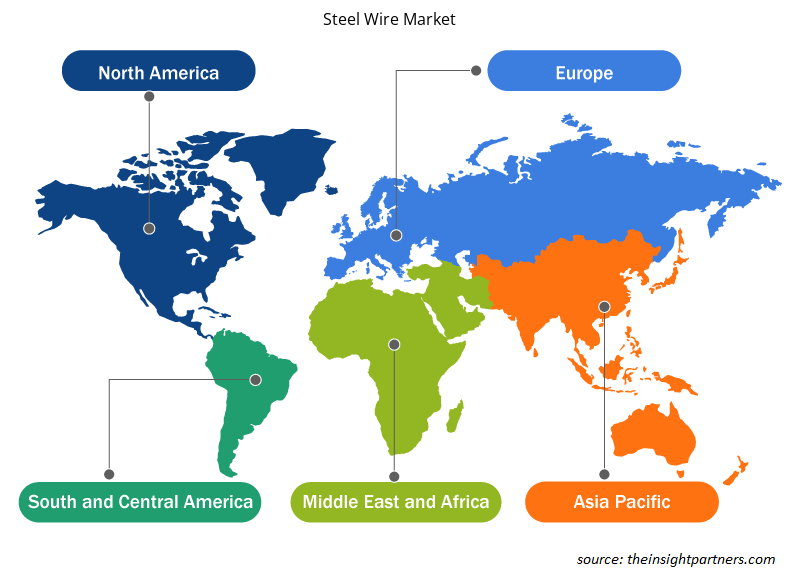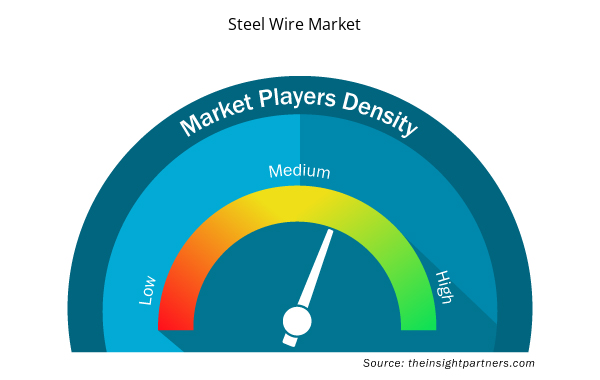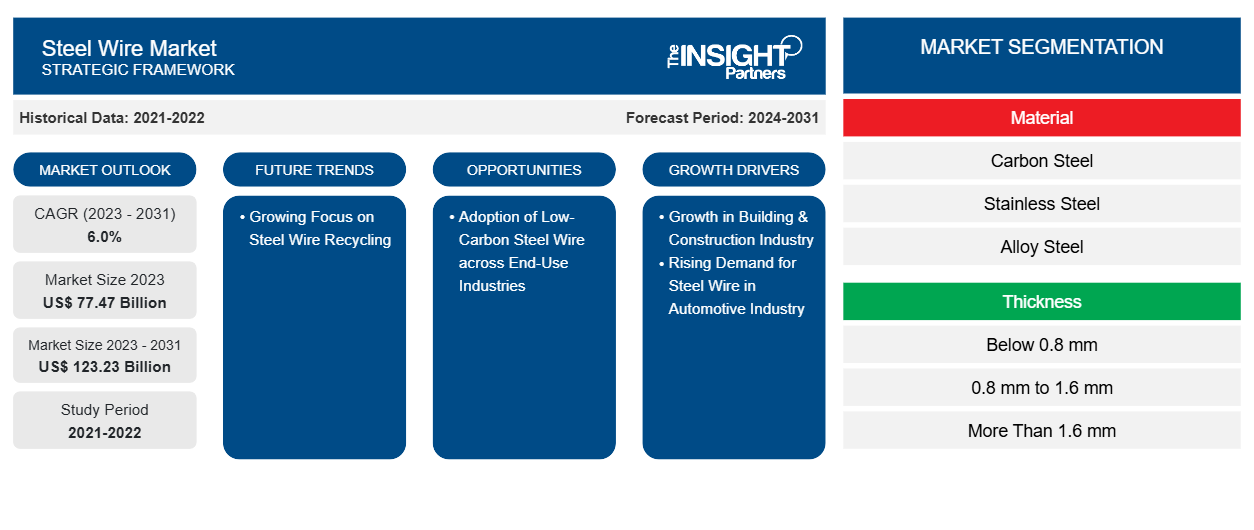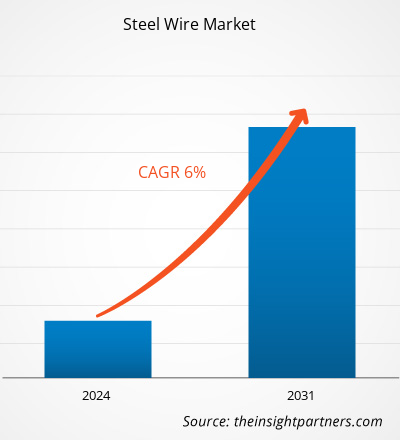预计到 2031 年,钢丝市场规模将从 2023 年的 774.7 亿美元增至 1232.3 亿美元。预计 2023-2031 年期间,市场复合年增长率将达到 6.0%。人口激增和汽车电气化导致建筑行业出现巨大发展,这是钢丝市场当前的变革趋势。
钢丝市场分析
钢丝网用于住宅和商业建筑中楼板和墙壁的混凝土加固。在基础设施开发项目中,工程钢丝网用于建造桥梁和护栏。随着对基础设施项目的大量投资,钢丝市场正在加速发展。此外,由于低碳钢相当坚固耐用,它是建造暴露在极端天气条件下的建筑物的首选材料。随着可持续发展趋势的日益增长,各个行业越来越多地采用低碳钢以最大限度地减少对环境的影响。因此,预计终端行业采用低碳钢丝将在未来几年为市场创造潜在的增长机会。
钢丝市场概况
钢丝广泛用于制造钢丝网、钢丝绳和电缆等。它由多种材料制成,例如碳钢、合金钢和不锈钢。不锈钢是一种低成本、耐腐蚀且耐用性高的材料。不锈钢丝具有各种尺寸和形状,因此适用于不同的应用。此外,碳钢是一种由碳和铁组成的合金。碳钢丝是通过将热轧棒通过较小的模具拉制而生产的。拉制过程使钢变硬,使其更坚固。合金钢由碳和锰、铬、镍、钼和钒等合金材料制成。合金钢丝制造工艺包括在电弧炉中熔化原材料。此外,由于钢丝用途广泛,它在建筑应用中得到广泛应用。它为建筑物和结构提供强度、耐用性和安全性。
定制此报告以满足您的需求
您可以免费定制任何报告,包括本报告的部分内容、国家级分析、Excel 数据包,以及为初创企业和大学提供优惠和折扣
- 获取此报告的关键市场趋势。这个免费样品将包括数据分析,从市场趋势到估计和预测。
钢丝市场驱动因素和机遇
汽车行业对钢丝的需求不断增长
由于技术进步以及对 SUV、跨界车和其他轻型卡车的偏好激增,汽车行业正在经历强劲增长。根据欧洲汽车制造商协会 (ACEA) 2023 年 1 月发布的报告,北美汽车产量与 2021 年相比增长了 10.3%,2022 年达到 1040 万辆。同样,韩国的乘用车产量在同一时期增长了 7.6%,达到 340 万辆。ACEA 发布的报告指出,2022 年全球乘用车产量为 6800 万辆,与 2021 年相比增长了 7.9%。
根据国际汽车制造商组织 (OICA) 的数据,2021 年北美和南美及中美洲的商用车和乘用车产量超过 1610 万辆;这一数字增长了 10%,2022 年商用车和乘用车产量超过 1770 万辆。一些汽车公司正在大力投资汽车制造,以提高产量和整体销量。根据国际能源署的年度《全球电动汽车展望》,2022 年全球售出了超过 1000 万辆电动汽车,预计到 2023 年销量将增长 35%,达到 1400 万辆。钢丝在汽车工业中有着广泛的应用,包括弹簧、电缆、悬架部件和其他线束部件。钢丝用于制造保险杠、座椅框架、方向盘和电缆等部件。因此,汽车行业对钢丝的需求不断增长,推动了市场增长。
终端行业对低碳钢丝的采用
低碳钢具有多种优势,例如在低温下强度高、耐用性强。全球向可持续发展的转变鼓励了各行各业采用低碳钢,从而最大限度地减少了环境问题。低碳钢丝广泛用于制造弹簧、金属丝网、钢筋、隔墙板、电缆和物料搬运应用。低碳钢丝还用于桥梁、甲板和阳台的结构施工。此外,在航空航天工业中,它还用于制造起落架支柱。在汽车工业中,它用于制造汽车零部件。2024 年 3 月,纽柯公司宣布与梅赛德斯奔驰达成一项新协议,为该汽车制造商位于美国阿拉巴马州的生产工厂供应低碳钢。这是该汽车制造商与梅赛德斯奔驰签署的一系列协议中的最新一项,其中包括位于阿拉巴马州的工厂与 Steel Dynamics 和 H2 Green Steel(一家瑞典初创公司)达成的协议,为欧洲的汽车供应低碳钢。因此,预计终端行业采用低碳钢丝将在预测期内为钢丝市场增长创造大量机会。
钢丝市场报告细分分析
有助于钢丝市场分析的关键部分是材料、厚度和应用。
- 根据材料,钢丝市场分为不锈钢、碳钢和合金钢。碳钢部分在 2023 年占据了最大的市场份额。
- 根据厚度,市场分为 0.8 毫米以下、0.8 毫米至 1.6 毫米和 1.6 毫米以上。2023 年,0.8 毫米至 1.6 毫米部分占据了市场的最大份额。
从应用方面来看,市场细分为建筑、汽车、航空航天、采矿、海洋、农业等。2023 年,建筑行业占据了市场主导地位。
钢丝市场份额按地区分析
钢丝市场报告的地理范围主要分为五个区域:北美、亚太、欧洲、中东和非洲、南美和中美。
2023 年,亚太地区占据钢丝市场份额的主导地位。根据国际贸易管理局的数据,中国在“十四五”期间(2021-2025 年)的基础设施总投资预计将达到约 4.2 万亿美元。此外,2022 年,中国国家发展和改革委员会 (NDRC) 和交通运输部公布了《国家公路网规划》文件,重点是建设高效、绿色、智能、安全的现代公路网,预计到 2035 年完成。该计划还涉及修建 461,000 公里的高速公路,其中包括 162,000 公里的高速公路。在建筑行业,不锈钢丝用于锚固建筑物和提升重物、建造桥梁和悬挂脚手架系统。因此,建筑行业的发展预计将在未来几年推动亚太地区的钢丝市场。
2023 年,欧洲占据钢丝市场第二大份额。根据挪威能源部和挪威海上管理局的数据,挪威是天然气的主要出口国,2022 年原油、凝析油和天然气的出口额为 1811.2 亿美元。根据美国能源信息署的数据,按数量计算,2023 年欧洲是美国原油出口的主要出口目的地。美国向欧洲国家进口的原油不断增加,进一步推动了海上运输和航运活动。钢丝用于制造钢丝绳,钢丝绳在各个行业中都有广泛的应用。在石油和天然气行业,钢丝绳用于提高钻机的生产率并最大限度地减少停机时间。它用于深水系泊、海上起重机和绞车以及钻井。因此,预计欧洲不断发展的海洋、建筑和汽车行业将在预测期内推动对钢丝的需求。
钢丝市场区域洞察
Insight Partners 的分析师已详细解释了预测期内影响钢丝市场的区域趋势和因素。本节还讨论了北美、欧洲、亚太地区、中东和非洲以及南美和中美洲的钢丝市场细分和地理位置。

- 获取钢丝市场的区域特定数据
钢丝市场报告范围
| 报告属性 | 细节 |
|---|---|
| 2023 年的市场规模 | 774.7亿美元 |
| 2031 年市场规模 | 1232.3亿美元 |
| 全球复合年增长率(2023 - 2031) | 6.0% |
| 史料 | 2021-2022 |
| 预测期 | 2024-2031 |
| 涵盖的领域 | 按材质
|
| 覆盖地区和国家 | 北美
|
| 市场领导者和主要公司简介 |
|
市场参与者密度:了解其对商业动态的影响
钢丝市场正在快速增长,这得益于最终用户需求的增加,这些需求是由于消费者偏好的不断变化、技术进步以及对产品优势的认识不断提高等因素所致。随着需求的增加,企业正在扩大其产品范围,进行创新以满足消费者的需求,并利用新兴趋势,从而进一步推动市场增长。
市场参与者密度是指在特定市场或行业内运营的企业或公司的分布情况。它表明在给定市场空间中,相对于其规模或总市场价值,有多少竞争对手(市场参与者)存在。
在钢丝市场运营的主要公司有:
- 安赛乐米塔尔公司
- 新日铁SG线材有限公司
- JFE钢铁公司
- 塔塔钢铁有限公司
- 神户制钢所
- 金沙西南钢铁有限公司
免责声明:上面列出的公司没有按照任何特定顺序排列。

- 了解钢丝市场顶级关键参与者概况
钢丝市场新闻及最新发展
钢丝市场通过收集一手和二手研究后的定性和定量数据进行评估,其中包括重要的公司出版物、协会数据和数据库。钢丝市场的一些发展情况如下:
- Ovako 与 FNsteel 签署合作协议,以降低整个欧洲盘条生产的碳强度。(来源:Ovako,新闻稿,2024 年 4 月)
- 塔塔钢铁宣布与印度钢铁和线材产品公司合并。通过此次合并,该公司整合了七家子公司,以实现协同效应、提高效率和降低成本。(来源:塔塔钢铁,新闻稿,2023 年 2 月)
- Schnitzer Steel Industries 推出了 GRN Steel,这是其 Cascade Steel 制造业务的净零碳产品系列。(来源:Schnitzer Steel Industries,新闻稿,2022 年 3 月)
- JSW Steel 从 Everbest Consultancy Services 收购了 Neotrex Steel,这是一个正在建设的低松弛预应力混凝土绞线项目。(来源:JSW Steel,公司网站,2021 年 3 月)
钢丝市场报告范围和交付成果
“钢丝市场规模和预测(2021-2031 年)”报告对以下领域进行了详细的市场分析:
- 范围内涵盖的所有主要细分市场的全球、区域和国家层面的钢丝市场规模和预测
- 钢丝市场趋势以及市场动态,如驱动因素、限制因素和关键机遇
- 详细的波特五力分析和 SWOT 分析
- 钢丝市场分析涵盖主要市场趋势、全球和区域框架、主要参与者、法规和最新市场发展
- 行业格局和竞争分析,涵盖市场集中度、热点图分析、知名参与者以及钢丝市场的最新发展
- 详细的公司简介
- 历史分析(2 年)、基准年、预测(7 年)及复合年增长率
- PEST 和 SWOT 分析
- 市场规模价值/数量 - 全球、区域、国家
- 行业和竞争格局
- Excel 数据集



Report Coverage
Revenue forecast, Company Analysis, Industry landscape, Growth factors, and Trends

Segment Covered
This text is related
to segments covered.

Regional Scope
North America, Europe, Asia Pacific, Middle East & Africa, South & Central America

Country Scope
This text is related
to country scope.
常见问题
steel wire is extensively used to fabricate steel wire mesh, steel wire rope, and cables, among others. It is manufactured from several materials, such as carbon steel, alloy steel, and stainless steel. Stainless steel is a low-cost, corrosion-resistant material with high durability. Wires made of stainless steel are highly adaptable for different applications as they are available in various sizes and shapes. Further, carbon steel is an alloy consisting of carbon and iron. Carbon steel wire is produced by drawing hot rolled rods through smaller dies. The drawing process hardens the steel, making it stronger. Alloy steel is made of carbon and alloying materials such as manganese, chromium, nickel, molybdenum, and vanadium. The alloy steel wire manufacturing process includes melting raw material in an electric arc furnace. Moreover, steel wire is highly utilized in construction applications due to its versatility. It provides strength, durability, and safety to buildings and structures. All these factors drive the steel wire market growth.
The automotive segment is expected to register the highest CAGR in the steel wire market from 2023 to 2031. The automotive industry is one of the major consumers of steel wire. steel wire is used to create a variety of components and assemblies, making it an essential component in the manufacturing of cars. steel wire is used for making springs, cables, and other suspension components, as well as connecting the internal wirings that allow the car to communicate with its various systems. steel wire is also used to reinforce plastic components, such as bumpers, to increase its strength and improve the safety of the car. Further, steel wire is used in the exhaust, steering, interior, and exterior components. All these factors are expected to drive the automotive segment growth from 2023 to 2031.
The 0.8 mm to 1.6 mm segment held the largest share of the global steel wire market in 2023. steel wire with thickness ranging from 0.8 mm to 1.6 mm provides balancing strength and flexibility. It is employed across a variety of industries due to its versatile mechanical properties and adaptability. The wire is manufactured precisely to ensure consistency in diameter and performance, thereby meeting diverse application requirements. It possesses high tensile strength, which helps endure significant loads and stresses without deformation. Its moderate thickness ensures flexibility is retained, enabling steel wire to be bent and shaped as needed. Moreover, this wire exhibits good wear resistance and enhanced corrosion resistance, making it suitable for both indoor and outdoor environments. All these factors led to the dominance of 0.8 mm to 1.6 mm segment in 2023.
The carbon steel segment held the largest share in the global steel wire market in 2023. Carbon steel is an alloy consisting of carbon and iron. Carbon steel wire is produced by drawing hot rolled rods through smaller dies. The drawing process hardens the steel, making it stronger. The wire is then heated, making it more ductile and malleable. The specific ratio of iron to carbon varies depending on the properties of the final product. There are four major types of carbon steel wire, i.e., low carbon steel wire, medium carbon steel wire, high carbon steel wire, and ultra high carbon steel wire. The properties of carbon steel wire include tensile strength, malleable nature, and hardness, which boosts its utilization in various industries. Carbon steel wire is used in construction and agriculture applications, manufacturing of clothes hangers, automobile parts, and various other applications. These factors led to the dominance of the carbon steel segment in 2023.
A few players operating in the global steel wire market include ArcelorMittal SA, Nippon Steel SG Wire Co Ltd, JFE Steel Corp, TATA Steel Ltd, Kobe Steel Ltd, JSW Steel Ltd, The HEICO Companies LLC, NV Bekaert SA, Tianjin Huayuan Metal Wire Products Co Ltd, and Henan Hengxing Science and Technology Co Ltd.
In 2023, Asia Pacific held the largest share of the global steel wire market. The rising urbanization rates have surged construction activities, particularly in the commercial and residential sectors. This, in turn, has accelerated the demand for steel wire products. Moreover, rising disposable income levels across Asia Pacific have empowered consumers to invest more in enhancing their living spaces. As a result, there has been a growing preference for construction materials options such as steel wire. All these factors led to the dominance of the Asia Pacific region in 2023.
Trends and growth analysis reports related to Chemicals and Materials : READ MORE..
The List of Companies - Steel Wire Market
- ArcelorMittal SA
- Nippon Steel SG Wire Co Ltd
- JFE Steel Corp
- TATA Steel Ltd
- Kobe Steel Ltd
- JSW Steel Ltd
- The HEICO Companies LLC
- NV Bekaert SA
- Tianjin Huayuan Metal Wire Products Co Ltd
- Henan Hengxing Science and Technology Co Ltd
The Insight Partners performs research in 4 major stages: Data Collection & Secondary Research, Primary Research, Data Analysis and Data Triangulation & Final Review.
- Data Collection and Secondary Research:
As a market research and consulting firm operating from a decade, we have published and advised several client across the globe. First step for any study will start with an assessment of currently available data and insights from existing reports. Further, historical and current market information is collected from Investor Presentations, Annual Reports, SEC Filings, etc., and other information related to company’s performance and market positioning are gathered from Paid Databases (Factiva, Hoovers, and Reuters) and various other publications available in public domain.
Several associations trade associates, technical forums, institutes, societies and organization are accessed to gain technical as well as market related insights through their publications such as research papers, blogs and press releases related to the studies are referred to get cues about the market. Further, white papers, journals, magazines, and other news articles published in last 3 years are scrutinized and analyzed to understand the current market trends.
- Primary Research:
The primarily interview analysis comprise of data obtained from industry participants interview and answers to survey questions gathered by in-house primary team.
For primary research, interviews are conducted with industry experts/CEOs/Marketing Managers/VPs/Subject Matter Experts from both demand and supply side to get a 360-degree view of the market. The primary team conducts several interviews based on the complexity of the markets to understand the various market trends and dynamics which makes research more credible and precise.
A typical research interview fulfils the following functions:
- Provides first-hand information on the market size, market trends, growth trends, competitive landscape, and outlook
- Validates and strengthens in-house secondary research findings
- Develops the analysis team’s expertise and market understanding
Primary research involves email interactions and telephone interviews for each market, category, segment, and sub-segment across geographies. The participants who typically take part in such a process include, but are not limited to:
- Industry participants: VPs, business development managers, market intelligence managers and national sales managers
- Outside experts: Valuation experts, research analysts and key opinion leaders specializing in the electronics and semiconductor industry.
Below is the breakup of our primary respondents by company, designation, and region:

Once we receive the confirmation from primary research sources or primary respondents, we finalize the base year market estimation and forecast the data as per the macroeconomic and microeconomic factors assessed during data collection.
- Data Analysis:
Once data is validated through both secondary as well as primary respondents, we finalize the market estimations by hypothesis formulation and factor analysis at regional and country level.
- Macro-Economic Factor Analysis:
We analyse macroeconomic indicators such the gross domestic product (GDP), increase in the demand for goods and services across industries, technological advancement, regional economic growth, governmental policies, the influence of COVID-19, PEST analysis, and other aspects. This analysis aids in setting benchmarks for various nations/regions and approximating market splits. Additionally, the general trend of the aforementioned components aid in determining the market's development possibilities.
- Country Level Data:
Various factors that are especially aligned to the country are taken into account to determine the market size for a certain area and country, including the presence of vendors, such as headquarters and offices, the country's GDP, demand patterns, and industry growth. To comprehend the market dynamics for the nation, a number of growth variables, inhibitors, application areas, and current market trends are researched. The aforementioned elements aid in determining the country's overall market's growth potential.
- Company Profile:
The “Table of Contents” is formulated by listing and analyzing more than 25 - 30 companies operating in the market ecosystem across geographies. However, we profile only 10 companies as a standard practice in our syndicate reports. These 10 companies comprise leading, emerging, and regional players. Nonetheless, our analysis is not restricted to the 10 listed companies, we also analyze other companies present in the market to develop a holistic view and understand the prevailing trends. The “Company Profiles” section in the report covers key facts, business description, products & services, financial information, SWOT analysis, and key developments. The financial information presented is extracted from the annual reports and official documents of the publicly listed companies. Upon collecting the information for the sections of respective companies, we verify them via various primary sources and then compile the data in respective company profiles. The company level information helps us in deriving the base number as well as in forecasting the market size.
- Developing Base Number:
Aggregation of sales statistics (2020-2022) and macro-economic factor, and other secondary and primary research insights are utilized to arrive at base number and related market shares for 2022. The data gaps are identified in this step and relevant market data is analyzed, collected from paid primary interviews or databases. On finalizing the base year market size, forecasts are developed on the basis of macro-economic, industry and market growth factors and company level analysis.
- Data Triangulation and Final Review:
The market findings and base year market size calculations are validated from supply as well as demand side. Demand side validations are based on macro-economic factor analysis and benchmarks for respective regions and countries. In case of supply side validations, revenues of major companies are estimated (in case not available) based on industry benchmark, approximate number of employees, product portfolio, and primary interviews revenues are gathered. Further revenue from target product/service segment is assessed to avoid overshooting of market statistics. In case of heavy deviations between supply and demand side values, all thes steps are repeated to achieve synchronization.
We follow an iterative model, wherein we share our research findings with Subject Matter Experts (SME’s) and Key Opinion Leaders (KOLs) until consensus view of the market is not formulated – this model negates any drastic deviation in the opinions of experts. Only validated and universally acceptable research findings are quoted in our reports.
We have important check points that we use to validate our research findings – which we call – data triangulation, where we validate the information, we generate from secondary sources with primary interviews and then we re-validate with our internal data bases and Subject matter experts. This comprehensive model enables us to deliver high quality, reliable data in shortest possible time.


 获取此报告的免费样本
获取此报告的免费样本